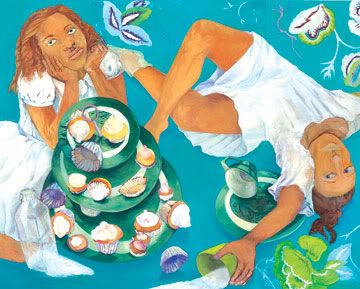PHILEMONA WILLIAMSON PAINTS PRETEEN FEMALES who float in pairs across canvas with the lightness of schoolgirls at a moon-struck tea party. There is a charm, even a sweetness, to them that sets them far afield from the surrealist frisson to which the exhibition lays claim. Figures drift and turn in gravity-free spaces, more like untethered astronauts than Chagall’s airborne couples. Topsy-turvy cupcakes, hovering goblets, stylized flowers and buoyant oddments provide local color for dreamy narratives that waft over the surface with the insubstantiality of light fiction.
//

//
Williamson is a talented illustrator. She is a capable draftsman with a fine sense of color and composition. Her juxtapositions of color areas, each with its delicate tonal transitions, are undeniably deft. “Garden Gift,” for example, tucks two pairs of shoes—one vermillion, the other a lucent cadmium red— into the variegated leaves of a row of purpled fall cabbages. The auburn hair of one girl echoes the warmth of the reds below and moves the eye up and across the image. The entire canvas is infused with a blush that underscores the girlishness of the motif.

//
But surface appeal is not enough to cover for the slenderness of the work as a whole. What Williams does not have is an adult reason to paint. The work’s weightlessness is as much conceptual as compositional. For all the earnest claims of the gallery’s press material (“the searching, the alienation and the commonplace tempests encountered in the growth to maturity”), nothing more consequential resides in these motifs than in the decoration of a girl’s room. If a visual analogy were needed for chick lit, this would fit the bill. There is a certain cuteness to these vacant-eyed little girls that is better suited to picture books than to a gallery setting. Serious narrative painting requires a more mature and sustained ambition than what is visible here. Perhaps it will come.
Philemona Williamson: Fractured Tales at June Kelly Gallery, 166 Mercer St., 212-226-1660.
This review appeared first in CityArts, November 23, 2010.
//
© 2010 Maureen Mullarkey


